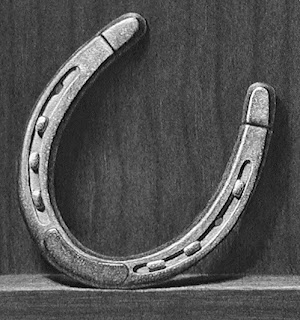Sunday, 3 February 2013
Horseshoes/Information on Shoeing your horse
The horseshoe is one of the most recognisable objects when anyone thinks of horses. For centuries the horseshoe has been a symbol of good luck and is still used in many cultures today as a talisman offering protection against evil forces. Traditionally, horseshoes are even given as wedding gifts as a good luck charm for the years ahead!
Perhaps more commonly in horse care, however, horseshoes are used primarily as their name might suggest - to provide protection against hoof damage for working horses.
Many changes brought about by domestication of the horse have led to a need for shoes for number of reasons, mostly linked to horses' hooves hardening less and being more vulnerable to injury.
In the wild, a horse may travel up to 50 miles per day to obtain adequate forage. While horses in the wild would traditionally cover large areas of hard, dry terrain, this was usually achieved at relatively slow speeds, unless being chased by a predator, so there were little fluctuations in activity or pace that would affect horses' hooves enough to require shoes.
The result of slow but non-stop travel in a dry climate is that horses' feet are naturally worn to a small, smooth, even and hard state - the continual stimulation of the sole of the foot keeps it thick and hard. However, modern day domesticated horses are used in very different ways, which can alter the state and condition of their hooves.
Domesticated horses, were brought to colder and wetter areas than their ancestral habitat. These softer and heavier soils soften the hooves and have made them prone to splitting, making hoof protection necessary. Consequently, it was in northern Europe that the nailed horseshoe arose in its modern form.
Most domesticated horses in the present day are subject to inconsistent movement between stabling and work, where they must carry or pull additional weight, and are often kept and worked on very soft footing, such as irrigated land, arena footing, or stall bedding. In some cases, management of horses and their hooves is also inadequate, causing, or perhaps overlooking problems that can pose a threat of disease and discomfort.
The hooves of horses that are kept in stalls or small turnouts, even when cleaned adequately, are also exposed to more moisture than would be encountered in the wild, as well as to ammonia from urine. As a result, the hoof capsule, which is mostly made from the protein, keratin, is weakened by this exposure, becoming even more fragile and soft.
Shoes do not prevent or reduce damage from moisture and ammonia exposure. Rather, they protect already weakened hooves. Further, without the natural conditioning factors present in the wild, the feet of horses grow overly large and long unless trimmed regularly. Hence, protection from rocks, pebbles, and hard, uneven surfaces is lacking.
A balanced diet with proper nutrition also is a factor. Without these precautions, cracks in overgrown and overly brittle hoof walls are a danger, as is bruising of the soft tissues within the foot because of inadequately thick and hard sole material.
For more information on horse care products to help you properly look after your horses and ponies, got to the official TicTac Equestrian site.
Subscribe to:
Post Comments (Atom)

No comments:
Post a Comment